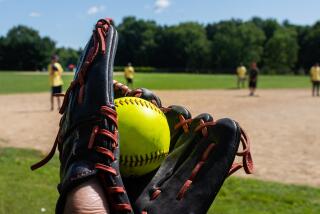L.A. City College Steps Into Future
- Share via
Time hasn’t been kind to Los Angeles City College, the site of the original UCLA campus and an alma mater of such Hollywood actors as Robert Vaughn and James Coburn.
The tightly packed, 48-acre campus in east Hollywood is dotted with tired buildings put up in the Great Depression. Its newest structure is 20 years old.
“When I first came here, I looked at this campus and wondered why I decided to come,” said Mary S. Spangler, president of the school and an administrator there since 1994.
But today the school will formally launch $147 million in construction and renovation projects to revitalize the campus. The aim is to modernize the facilities while making the campus, which is easy to miss while driving by, more inviting to residents of the Hollywood area.
Projects scheduled to be constructed over the next five years include a student admissions center; a math, science and technology building; and a health, fitness and physical education facility. They will be among the first major construction efforts stemming from voters’ approval in April 2001 of Proposition A, a $1.2-billion bond issue program for the Los Angeles Community College District.
Marshall “Mark” Drummond, chancellor of the community college district, said the improvements are badly needed. Los Angeles City College, the oldest of the district’s nine campuses, was established as a two-year school in 1929 after previously serving as the campus for UCLA and its predecessor schools dating to 1914.
“They’ve made some strides in the last few years, but with a number of buildings, like the [chemistry] building, it’s just hopeless,” Drummond said, referring to a 1930s-vintage building to be replaced by the new math, science and technology facility.
Drummond added that the existing men’s physical education building, also being torn down for a new facility, “is so old that we’ve had the pool condemned for years. It’s really good to get that out of there. It almost borders on being an unsafe building.”
Spangler, the campus president for five years, says the new buildings will house some new academic and student service programs. The math, science and technology building, for example, eventually will house a nursing program being launched this semester, a full 17 years after the campus’ last one was shut down.
For that move, Spangler has drawn praise from Assemblywoman Jackie Goldberg (D-Los Angeles), whose mother studied at the city college campus when it still was the site of UCLA.
The campus has three hospitals nearby: Childrens Hospital Los Angeles, Kaiser Permanente Medical Center and Queen of Angels-Hollywood Presbyterian Medical Center.
“Not to have a nursing program, to me, was just a crime,” Goldberg said.
The new program “will mean a lot to that community, because there are a lot of folks who would like to become nurses, and we have a terrible nursing shortage.”
The projects funded with the Proposition A money are just the first phase of a $250-million master plan developed by the college to guide development over the next 10 years.
In the next phase, Spangler hopes to add a $23-million library on the outer edge of the campus, which community residents would be encouraged to use. Later on, the school hopes to add a $25-million performing arts center.
The school’s attempts to upgrade in recent years have ignited some opposition. A deal with a developer to build a for-profit golf driving range at Melrose and New Hampshire avenues, on five acres of college property immediately south of the current campus, is being challenged in a campaign led by an alumnus, Duke Russell, who calls it a misuse of public land. He said he is trying to find financial backers to challenge the deal in court.
Russell also considers it wasteful to use $2 million of Proposition A money to move the school’s athletic field to another area of the campus.
Spangler said the college and the district, in hindsight, “probably” should not have pursued the golf course deal, which is expected to bring the school $1.2 million over 10 years.
But she explained that the district legally obligated itself to go forward before Proposition A passed, when the college was in far weaker shape financially. In addition, Spangler said, the college can take back the land in 10 years.
Spangler expressed no reservations about plans for the athletic field, which is to be moved from the corner of Vermont and Willowbrook avenues, on the northeast corner of the campus, to the southwest corner of campus near Melrose Avenue.
Spangler said she wants to create a dramatic entrance for the campus at Vermont and Willowbrook that will both “make a statement” to the surrounding community and take advantage of proximity to the MTA Red Line station. It will feature a grove of trees and maybe a water fountain and bell tower.
“Too much of what I heard when I first came here was that people ride by on the bus and they don’t even know what’s beyond the walls here,” Spangler said.
“When you come up from the MTA station now, what greets you? A chain-link fence and a field, and you can’t access the college,” she added. “By moving the stadium to the other part of the campus ... we now can open up that door.”
More to Read
Sign up for Essential California
The most important California stories and recommendations in your inbox every morning.
You may occasionally receive promotional content from the Los Angeles Times.













